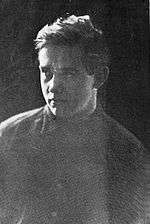Avard Fairbanks
| Avard Fairbanks | |
|---|---|
|
Fairbanks (ca. 1914) | |
| Born |
Avard Tennyson Fairbanks March 2, 1897 Provo, Utah |
| Died |
January 1, 1987 (aged 89) Salt Lake City, Utah |
| Resting place |
Larkin Sunset Lawn Cemetery 40°44′28″N 111°49′23″W / 40.741°N 111.823°W |
| Alma mater | University of Michigan |
| Occupation | Sculptor |
| Spouse(s) | Beatrice M. Fox |
| Parent(s) |
John B. Fairbanks Lillie A. Huish |
Avard Tennyson Fairbanks (March 2, 1897 – January 1, 1987) was a prolific 20th-century American sculptor. Three of his sculptures are in the United States Capitol,[1] and the state capitols in both Utah and Wyoming, as well as numerous other locations, also have his works. Possibly his most well-known artistic contribution was designing the ram symbol for Dodge.[2]
Fairbanks studied in at the Art Students League of New York beginning at age 13 and the École Nationale Supérieure des Beaux-Arts in the atelier of Jean Antoine Injalbert beginning at age 17.[3] Fairbanks received his bachelor's degree from Yale University and his master's degree from the University of Washington.[4] For three years Fairbanks studied on a Guggenheim Fellowship in Florence, Italy. He received his Ph.D. in anatomy from the University of Michigan. He was also a professor of sculpture at the University of Michigan.[5]
Family
His father was John B. Fairbanks, who was an artist and art professor. His mother, Lilly Annetta Huish, died about a year after he was born. She was a cousin of Orson Pratt Huish. Avard's brother J. Leo Fairbanks was also an artist, and helped Fairbanks start sculpting as a teenager.[5]
While Fairbanks was living in Ann Arbor, he served for a time as the president of the branch of The Church of Jesus Christ of Latter-day Saints in that city.[4]
Among Fairbanks' children is Jonathan Leo Fairbanks, who was curator of the Boston Museum of Fine Arts in the early 1990s.[6]
Fairbanks also briefly served as a foster parent to Jack Henry Abbott as detailed in Abbott's second book, My Return.
Works
In 1918, Avard worked with his brother J. Leo Fairbanks on friezes for the Laie Hawaii Temple. It was during this time that he married Beatrice Maude Fox in Honolulu, Hawaii. She was a native of Salt Lake City whom he had met in Utah and convinced to come join him in Hawaii so they could marry. This would not be Fairbanks' last connection with temples. The statues of the Angel Moroni on the Washington D.C. Temple, the Jordan River Utah Temple, Seattle Washington Temple and the São Paulo Brazil Temple are all Fairbanks' work.

Many of the sculptures on Temple Square in Salt Lake City are by Fairbanks, including the Three Witnesses Monument.[7]
For a time in the 1920s Fairbanks was a member of the faculty of the University of Oregon.[8] It was while here that he made his Oregon Trail sculpture. Around 1925–26, he designed several bas relief panels, cast in bronze, for large doors of the United States National Bank Building, in Portland.[9] Fairbanks later became a professor at the University of Utah.
He created a sculpture of the restoration of the Melchizedek priesthood for the Mormon Pavilion at the 1964 New York World's Fair.[10]
Although most of his later work was free-standing sculptures, Fairbanks did return to the frieze when he made some for the Harold B. Lee Library on Brigham Young University campus.[3]
Fairbanks made a statue of Lycurgus that led to his being knighted by King Paul of Greece. He also did multiple statues of Abraham Lincoln (including The Chicago Lincoln) and George Washington.[3]

He created the Pegasus sculpture in the northeast garden at the Meadow Brook Hall in Rochester Hills, Michigan.[3]
See also
- Mormon art
- Ortho R. Fairbanks, nephew
- The Pioneer Mother Memorial (1928), Vancouver, Washington
Notes
- ↑ Viles, Philip H. Jr., National Statuary Hall: Guidebook for a Walking Tour, Published by Philip H. Viles, Tulsa OK, 1997
- ↑ Avard T. Fairbanks, designer of the Dodge Ram symbol and the Plymouth Flying Lady hood ornaments
- 1 2 3 4 Garr et al., Encyclopedia of Latter-day Saint History, p. 355
- 1 2 Church News, September 17, 1994
- 1 2 The Life of Avard T. Fairbanks
- ↑ Church News, March 6, 1993
- ↑ Church News, April 4, 1992
- ↑ Greenthal, Kozol, Rameirez & Fairbanks, American Figurative Sculpture in the Museum of Fine Arts, Boston, Museum of Fine Arts, Boston 1986
- ↑ John M. Tess (December 1985). "National Register of Historic Places Inventory – Nomination Form: United States National Bank Building" (PDF). National Park Service. Item Number 7, p. 2. Retrieved 2016-04-29.
- ↑ Top, Brent L., "The Miracle of the Mormon Pavilion: The Church at the 1964-1965 New York World's Fair" in Porter, Larry C., Milton V. Backman Jr. and Susan Easton Black, ed., Regional Studies in Latter-day Saint History: New York (Provo: BYU Department of Church History and Doctrine, 1992) p. 245
Further reading
- Fairbanks, Eugene F. (1994) [1972], A Sculptor's Testimony in Bronze and Stone: the Sacred Sculpture of Avard T. Fairbanks (Rev. ed.), Salt Lake City, Utah: Fairbanks Art and Books (printer: Publishers Press), ISBN 0-916095-58-4, OCLC 32926833.
- Avard Fairbanks, Utah Artists Project, University of Utah
- Oman, Richard G. (1992), "Sculptors", in Ludlow, Daniel H, Encyclopedia of Mormonism, New York: Macmillan Publishing, pp. 1285–1286, ISBN 0-02-879602-0, OCLC 24502140
External links
| Wikimedia Commons has media related to Avard Fairbanks. |
- avardfairbanks.com
- Avard Fairbanks at Find a Grave
- Avard T. Fairbanks papers, MSS 5866 at L. Tom Perry Special Collections, Brigham Young University
- Fairbanks, Avard, Life of Avard T. Fairbanks, Sculptor,(MSS 7396), L. Tom Perry Special Collections, Harold B. Lee Library, Brigham Young University.
